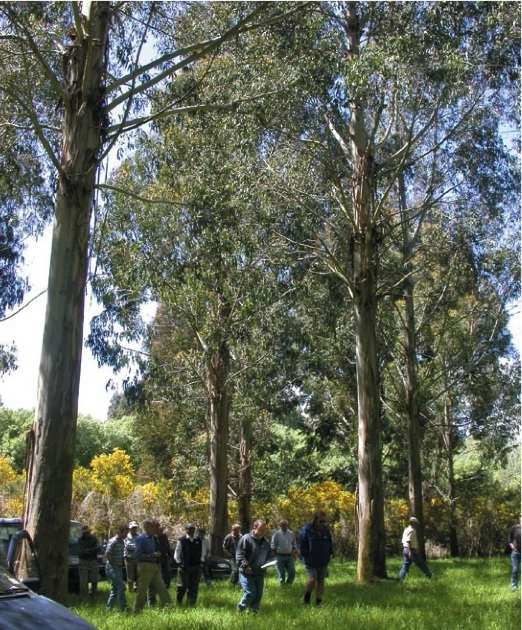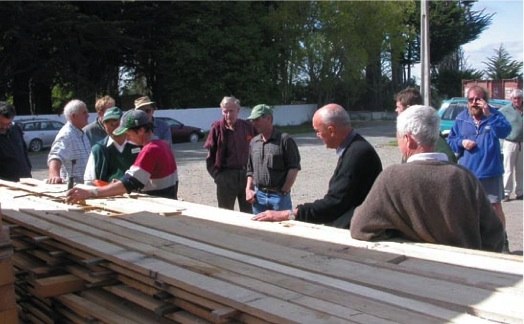The commercial reality of special purpose timber species
Parnell Trost, New Zealand Tree Grower May 2005.
Securing an adequate return for your stand of eucalypts or macrocarpa can be the most challenging part of the growing cycle. The market for special purpose timbers is relatively small, and there is only a limited number of sawmillers who are experienced in handling these species.
To meet this challenge, growers need to research the markets and final products for their timber, identify which mills have the ability to process specialised logs, and determine what is the optimal age or diameter for harvesting.
Production trial
These were the questions facing Graham Milligan, of Dipton in northern Southland, as he looked out on his maturing stands of Eucalyptus nitens and E. regnans. To answer these questions, Graham arranged for a production trial on a selection of his plantings. The results from the trial were examined as part of a Southland Farm Forestry field day in late 2004.
The field day covered the management and milling of specialist timber species, the markets for these timbers and the direction of current research. The presenters were Roger Stodart, Rural Sawmill Limited, Patrick Milne, Southern Cypresses, and Graham Milligan, Milligan Seeds and Trees.

Optimising the returns from eucalypts
Roger Stodart stressed that the recovery rate from a stand of eucalypts is closely related to the time it takes to transport the logs from the harvest site to the mill. In Australia, the preferred time period is one day. If logs have to be left for a few days, they are usually sprayed or placed in ponds to slow the rate of end splitting. Logs left for three or four days without spraying will have significant splitting and will be downgraded. The critical issue is to co-ordinate the rate of cutting with the demand of the mill. Careful attention also needs to be paid to transport scheduling.
The problems do not end with the log reaching the mill. Successfully turning eucalypts into sawn timber requires an experienced operator, who knows how to counteract the internal stresses within the log, to prevent it from splitting and bowing. The operator has to keep turning the log on the carriage to relieve these pressures.
Younger, smaller diameter logs generally have more severe internal stress gradients than older logs. Once the timber is sawn, it is left to naturally air dry in the shade for six to eight months. Sawn eucalypt cannot be left out in exposed sun. The timber is then kiln dried slowly, at a medium temperature, to bring it down to a moisture content of between 10% and 12%.
The principal market for sawn eucalypt is household flooring. There is also some demand for furniture production. Builders are generally seeking 150 mm by 25 mm and 100 mm by 25 mm tongue and groove for flooring. To produce these dimensions, mills require logs with a small end diameter of at least 300 mm. Smaller logs are financially marginal. The consumer preference is for clear timber, without black knots or cracks. There is some demand for timber with tight knots, but there are few market opportunities for the knotty, upper sections of the tree other than chipping and firewood.
One of the obstacles timber processors face in developing the market for eucalypt timber is the lack of consistent supply. Instability in supply affects consumer demand and pricing arrangements.

The results from the Milligan production trial
Roger Stodart considered the logs from the Milligan property were some of the best he had seen in terms of sawing characteristics. A high recovery rate was obtained and the timber was of an even quality. This was put down to the large diameter of the logs and the intensive management regime, particularly the small defect core.
The sawn timber had consistent colouring and Roger was confident that there would be strong demand for the timber. One of the likely options for the timber was the Christchurch flooring market.
Maximising the clear-wood component in macrocarpa
Both Patrick and Roger argued for early and intensive management of macrocarpa stands, as their economic value is determined by the volume of clear-wood that is available for processing.
Recent experience has shown that macrocarpa, and cypress species generally, can be pruned at a relatively young age, with minimal impact upon height and diameter growth. An early pruning regime limits the defect core and there are also savings in management costs. With intensive management, a harvest age of 36 to 40 years would be feasible.
If the pruning cycle has already been completed, consideration could be given to reducing the stocking rate. Patrick illustrated this point during a site visit to a block established in 1986, and which had recently been thinned to 600 to 700 stems per hectare. To maximize the clear-wood component he recommended a severe thin down to 300 to 400 stems. The growth increment is almost the same for the two stocking rates but significantly more clear-wood would be added at the lower rate. Even at 300 stems per hectare, there would be an opportunity for a further production thin later in the rotation. If a stand has received minimal tending, Roger recommended holding off harvesting until the trees are between 50 and 60 years of age.
The macrocarpa market
Patrick Milne reported that there continues to be solid demand for macrocarpa logs. Growers are receiving approximately $300 per tonne for good quality pruned butts landed at the mill. However growers have to remember that the preference is for clear timber, or for logs with small tight knots. This is due to the fact that macrocarpa goes into higher value products, where the appearance of the timber is the critical issue. There are limited market opportunities for the knotty core, or for heavily branched logs, particularly if they contain damaged or dead limbs.
On the supply side, conditions have tightened over the past eighteen months. One of the factors for this has been the slow-down in farm conversions to dairying. The conversion process normally involved removing a percentage of the shelterbelts and woodlots on a property. Shelterbelt logs are generally of a low quality, but most stands have a percentage of better grade timber. The tightening of supply has assisted in maintaining prices.
The discussion during the day highlighted that growers of special purpose species need to pay close attention to their management practices, as the markets for these timbers are limited, and the focus is on clear lengths, or timber with tight knots.
Dr Parnell Trost is a Policy Analyst with MAF in Dunedin

 Farm Forestry New Zealand
Farm Forestry New Zealand